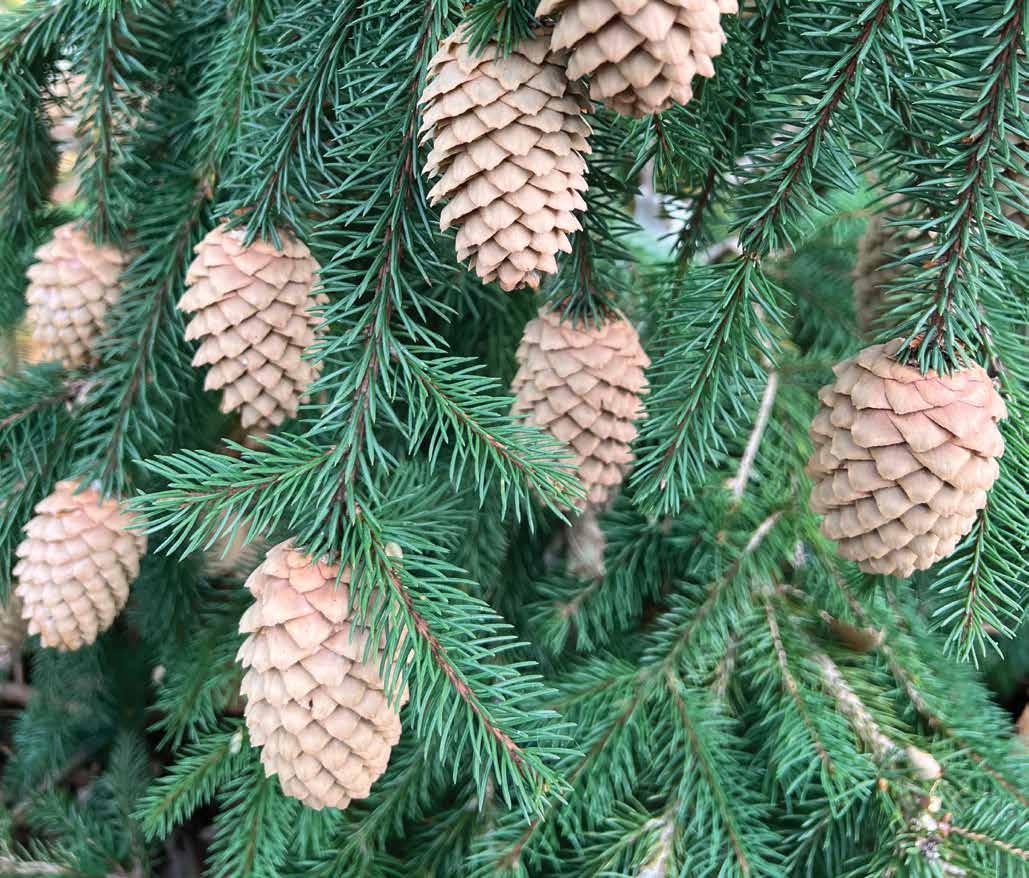
The
Kansas City


Kansas City
Independently owned and operated since 1996
PUBLISHER
Michael Cavanaugh
EDITOR
Elizabeth Cavanaugh
CONTRIBUTORS
Mr. Gardener
Markis Hill
Sidney Patrick Tamra Reall
Anthony Reardon
Elizabeth Stoakes
Anne Wildeboor
Scott Woodbury
DISTRIBUTION
Publishers Delivery Solutions, Inc.
IF
please contact Mike Cavanaugh
mike@kcgmag.com 913-648-4728
NEED MORE MAGAZINES? mike@kcgmag.com 913-648-4728
CONTACT US P.O. Box 8725 Prairie Village, KS 66208 913-648-4728
ADVERTISING
Mike Cavanaugh at mike@kcgmag.com 913-648-4728
QUESTIONS ABOUT EDITORIAL AND SUBSCRIPTIONS
Elizabeth Cavanaugh elizabeth@kcgmag.com 913-648-4728
HOW TO SUBSCRIBE
See details on page 19.
WEBSITE kcgmag.com

As fall gently slips away, the garden is drifting towards a deep winter sleep. Deciduous trees have shed their foliage, and the steadfast begonias finally have succumbed to the effects of freezing temperatures. The bird feeders are full, and the heated birdbath for wildlife water is now in place. The firewood man delivered our order, and now we’re ready for winter.
Next on the agenda—shop for a Christmas tree. Traditionally, this was a family event. Now that our kids are grown with families and traditions of their own, Mr. Gardener and I carry on a modified version of old traditions, while I hold in my heart treasured memories of long ago.
Tree selection was enthusiastic, even wild at times. The kids would run up and down every row, in search of the perfect tree. While Fraser Fir is our favorite, we looked at every tree, from small to tall, or wide to thin, considering all the possibilities. The kids like the really tall ones, and Dad likes the really “full” ones. And for me, it’s the smell. I love the fragrance of a fresh cut Christmas tree.
Once we made our purchase and threw it in the van, we headed home with sap on our hands and hope in our hearts. The holidays were un-
derway. The kids were eager to decorate, but we reminded them of the oh-so-necessary Christmas Tree soak (letting it sit overnight in the garage in a bucket of water to allow acclimation). After a few short-lived complaints, we scheduled decorating for a future date.
Decorating the tree was another one of those family traditions. We started with declaring no distractions—no phone, no visitors, no e-mail, and no television. There’s plenty of hot chocolate and a fire in the fireplace. And what would decorating the tree be without listening to our favorite Christmas carols, like “Joy to the World.”
By now we’ve heard the familiar sound of the chainsaw trimming the tree to fit the stand—the sound of “we paid for an 8-foot tree, now it’s a 6-foot tree.” But somehow that just didn’t matter. What matters is who should retrieve the boxes from the attic, who should open the boxes and who should hang what ornaments. Well, tradition speaks volumes. Kids get the boxes, Dad plus any volunteer hangs the lights and Mom decides the rest. Don’t you love traditions?
As I unwrapped each ornament from its tissue paper bed, a memory

filled me. I shared those memories with our children, in hopes that the spirit of another family tradition will plant itself for Christmases to come.
During this precious time together, we were nurturing family ties that cannot be broken, family bonds that will withstand the test of time. And hopefully, will be passed on to future generations. Looking back through the years, I am confident we did just that.
When the kids had gone to bed, I sat alone in our quiet living room admiring their work of love. The simple silent flicker in the fireplace is peaceful and serene, and I have another chance to discover the season’s simple joy. This practice remains today. I pray the same for you. I’ll see you in the garden!


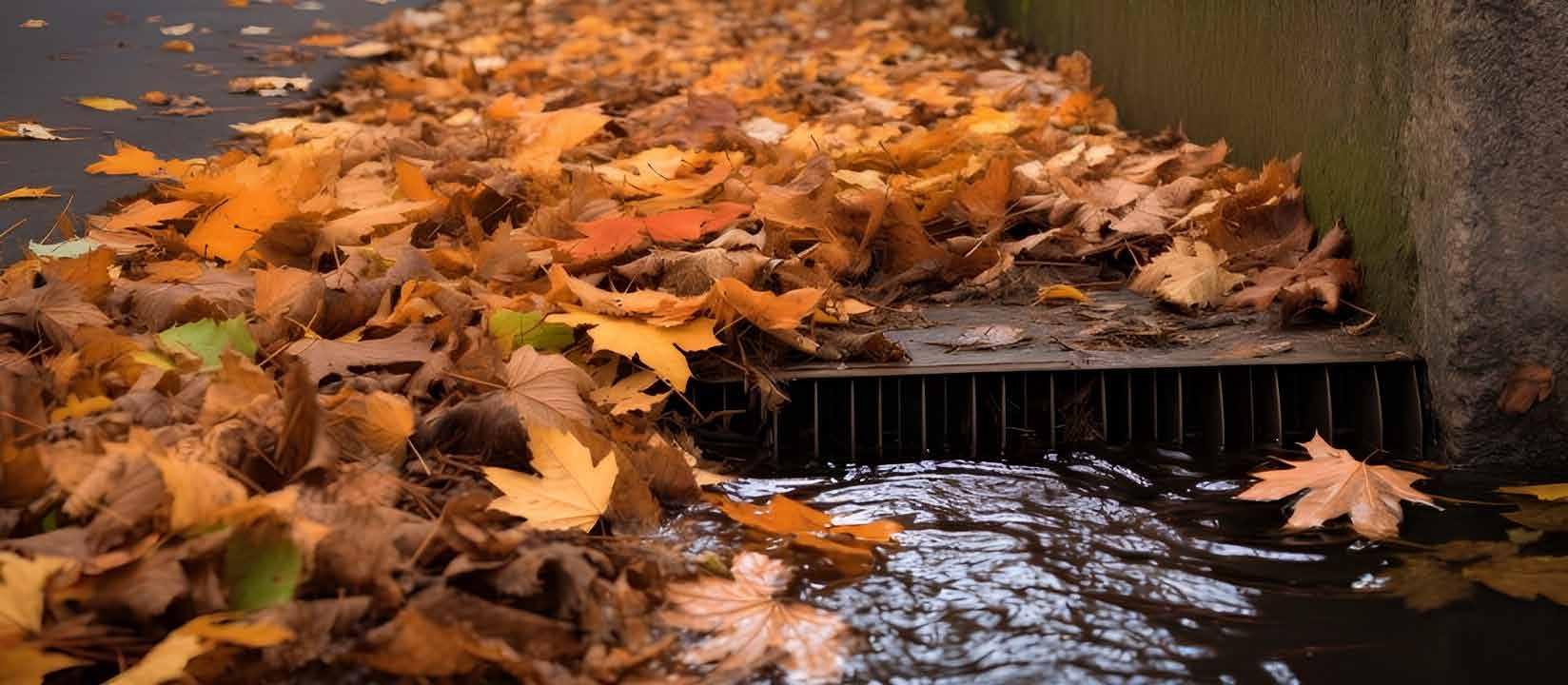



Question: With the winter downtime from my vegetable garden, I really want to delve into crop rotation planning for next year to give my garden that extra bit of pest protection. Any tips on this?
Anthony’s Answer: Crop rotation can be a very simple concept when you look at the bare bones of what it entails: no planting crops of the same genus in the same location as last year, no moving the crops to a new location where they’ll compete for water, light, or nutrients, and (preferably) no moving heavy feeder crops such as tomatoes or corn to a location where other heavy feeders have recently been (to preserve soil quality).
Ideally, this process is observed

through a three-year cycle, with no related plant material being reintroduced to a location during that time. When gardening in limited space, however, going year to year with your crop rotation can still be beneficial. Just remember, the entire purpose of crop rotation is to starve out crop-specific pests. If a related crop is planted too close to a previous year’s planting, the pests will likely be able to migrate and persist, so spacing is essential. Being sure to clear out any nesting debris within your garden now will also help in deterring these.
Question: Looking outside and seeing nothing but brown really has
me bummed out. What are some evergreen options that I should consider putting in my own yard?
Markis’ Answer: There are some great options available for this area of the Midwest. The first group of evergreens we think of is the grandiose conifer trees. It is essential to note, however, that Kansas has only one native conifer, the eastern red cedar (Juniperus virginiana). Although there are conifers that are U.S. natives and thrive in the Midwest, many of them will struggle with the environmental stress of this region. There is an excellent publication from K-State about the specific conifers for each area of Kansas titled “Conifer Trees for Kansas: A Guide to Landscape Evergreens” (MF3423). Each species listed has cultivars with distinct characteristics that can be utilized in various ways in the landscape.
There are also many evergreen trees and shrubs that are not conifers that work well here. For example, some holly species retain their green leaves throughout the year and thrive in our area. The Southern magnolia (Magnolia grandiflora), boxwood (Buxus microphylla), and bearberry cotoneaster (Cotoneaster dammeri) are also examples of broadleaf plants that retain their color during the winter months. For more information, see K-State publication titled “Evergreen Shrubs for Kansas” (MF3117).
Another group of plants that shouldn’t be overlooked are cactus plants. That’s right, there are a handful of cacti that survive the freezing temperatures of the Midwest and keep their color. The prickly pear cactus (Opuntia sp.) has several species that grow well in our zone.
Other cacti that would survive the cold of our climate include hedgehog cactus (Echinocereus sp.), cholla cactus (Cylindropuntia sp.), and dad’s cactus (Escobaria sp. or Coryphantha sp.).
Are there any succulents that don’t have pokey spines associated with them that are hardy to our winters? Yes! Hen and chicks are often thought of as hot desert plants, but they are actually not as heat-tolerant as other succulents and are also hardy to zone 4. They can be utilized in containers or in the ground. You do have to keep the squirrels away because they will steal them when it is very dry outside.
Question: I experienced some failures in my garden this past year, and I want to learn from them. What tips do you have for using my experiences to better next year’s garden?
Anthony’s Answer: Always remember, there are no “failures” in gardening—just learning moments! (Trust me, even we professional horticulturists see plenty of them.)
One of the best practices you can do after a growing season is to compare and contrast the year with your most successful year. How did production go? What practices changed? Often, the answer to this change will simply lie in environmental factors such as excessive rain or temperature fluctuations. Nevertheless, assessing ways you can best emulate that “perfect year” will be the ticket. Then, keeping a gardening journal moving forward can help with long-term improvement efforts (and memory ;)).
Anthony and Markis are the horticulture agents for Johnson County K-State Research and Extension, each specializing in edible crops and ornamentals, respectively. For free information fact sheets, visit www.johnson. ksu.edu, or call the Extension office at 913-715-7000.






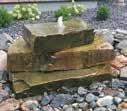


















Ever wonder what insects are up to while we’re untangling lights, sipping cocoa, and sprinkling cookies? While humans rush around planning for the holidays, insects are preparing to survive the winter. They don’t hang stockings or sing carols (though a cricket choir would be festive!), but they do have clever winter “traditions.” Let’s learn about some of these traditions while unwrapping insect biology.
Do bugs sleep?Where do they snooze during winter holidays?
Insects need rest. Their “sleep” is a lot like ours—they stay still, breathe slowly, and take a moment to wake up. They tend to find a sheltered place to sleep and even have regular cycles of when they rest and when they’re active. In winter, many insects go into a deep rest called diapause, kind of like a long winter’s nap. For example, ladybugs huddle together under leaves or inside cozy cracks. On the other hand, some butterflies migrate south for warmer “holiday vacations.” So, while you’re dreaming of sugarplums, insects are also tucked in tight, waiting for spring.
Do bugs have body parts like ours: brains, hearts, lungs?
Yes and no. For the yeses, they’re micro versions! Insects have brains, but they’re tiny and share the job with other nerve centers along their body. It’s like a team of mini control stations working together. A big beetle’s brain is about the size of a poppy seed, while social insects like honey bees and wasps have brains

closer to a sesame seed. Small, but smart enough for tricky jobs like flying, finding food, and recognizing faces. They also have hearts, but instead of pumping blood through veins like ours, their heart is a simple tube that moves a clear fluid called hemolymph throughout their body. Hemolymph is insect blood. And lungs? Nope! Insects breathe by having air pass through little holes along their abdomens called spiracles: fresh air flows in and stale air flows out.

Unwrapping its wings like a present, this ladybug is set for a journey.
Do bugs eat, pee, and poop like we do?
They do, although it looks different! Insects eat plants, other insects, or even leftover crumbs from your holiday cookies. Some insects have straws for mouthparts, while others chew their food. After eating, they poop (called frass) or excrete a dry powder called uric acid. Sometimes insects leave their frass where it falls, and others yeet it away so that predators are less likely to find them. You can see a grasshopper frass flick in this video: https://youtube.com/ shorts/BngBfKGl-j8.
Can all beetles fly ?
Not all beetles fly, but many can, and they do it with style! Beetles have two pairs of wings: the hard outer shell (elytra) and the soft flying wings folded up underneath.
Before takeoff, they lift the shell like opening a gift box, then zoom away. Some beetles, like ladybugs, soar gracefully almost like Santa’s reindeer. Others, like ground beetles, stay earthbound, guarding nature’s workshop.
Bonus: Who are Santa’s little helpers in the bug world?
Here are five helpful insects that deserve a spot on the Nice List:
• Ladybugs: Gobble up plant pests.
• Bees: Pollinate flowers so we have flowers and food.
• Butterflies: Spread pollen and beauty.
• Dung beetles: Clean up animal waste.
• Parasitoid wasps: Keep pest populations in check and they can’t sting!
The Bug Lab: Backyard science quests for curious kids (and grown-ups too!) Backyard Science Challenge: Ready to find out where
bugs spend their long winter’s nap?
Here’s your mission:
1. Gear up: Warm coat, notebook, magnifying glass, and a grown-up buddy.
2. Pick a spot: Leaf pile, under a log, or near tree bark.
3. Look for evidence:
° Ladybugs huddled like a holiday party.
° Beetles under rocks.
° Small “bug hotels” in cracks or piles of leaves.
4. Record your discoveries: Draw your findings or write a “Bug Holiday Report.”
° Download the printable challenge page here (or scan the QR code): https://bit.ly/ KADBhide-seek

5. Share what you find! Email: reallt@missouri.edu; Subject: KADB Bug Lab
Watch the Kids Ask Dr. Bug video series: https://bit.ly/ KADBvideos
Send your questions: https:// bit.ly/KidsAskDrBug
Play the firefly-catching game: https://bit.ly/CatchFireflies
Share feedback (we’d love to hear from you!): https:// bit.ly/KidsAskDrBugSurvey
Dr. Tamra Reall (@MUExtBugN Garden) is the horticulture specialist for MU Extension in Jackson County. For free, research-based gardening tips, call 816-833-TREE (8733), email mggkc.hotline@gmail.com, or visit www.extension.missouri.edu.








• rabbits, chipmunks, moles, groundhogs, mice, rats, squirrels, raccoons, skunks, opossums, snakes and bats
• woodpeckers, starlings, pigeons, sparrows and geese
• repairs and chimney caps
•
•














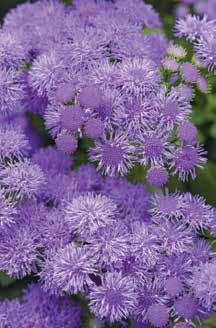

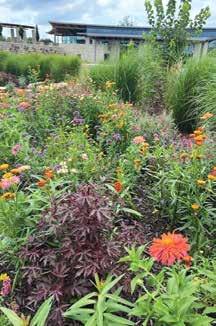
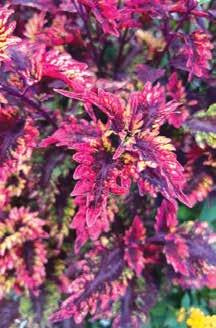
As this year wraps up, I am reflecting on what an amazing year 2025 was for me personally and professionally. My son graduated from high school, we went on some wonderful trips, the volleyball teams that I coach had great success, and the gardens at work were exceptionally lovely.
This is my eleventh year at the Overland Park Arboretum & Botanical Gardens. Since my arrival, the garden space that we care for has almost doubled. With the addition of the new Longhouse Visitors Center in 2023, over 8,000 new plants were planted. We have worked hard to add to these new spaces, brightening them up with annuals and tucking in more fun perennials. This year, all that hard work began to show dividends. Beautiful gardens with abun-

dant blooms, tons of butterflies and hummingbirds.
The weather also contributed to the beauty in our gardens. The snowfall we had at the beginning of the year led to great spring flowering trees and bulbs. The temperatures also stayed consistent once we put our spring annuals in the ground, resulting in full displays and our bulbs showing off without getting burnt by a late spring frost.
May temperatures were mild and fantastic. Our spring displays held on and we were able to get some summer annuals in the ground and established without scorching hot temperatures. Summer gave us our normal hot, humid Kansas weather, but timely rains helped the gardens immensely, and gave our gardens a tiny respite.
ANNE WILDEBOOR Horticulturist
Fall unfortunately was pretty dry, which led to lots of watering. If you have not been watering your trees, shrubs and perennial plants, we are still having warm days where you can give plantings a beneficial good soaking. People often overlook watering this time of year because temperatures are cooler and our plants don’ t show stress like they do in the summer months. Moisture going into winter is vitally important to your plants ability to survive the winter.
Reflecting on the beauty, here were some of my favorites from 2025, that will definitely be on my list in 2026.
Ageratum ‘Monarch Magic’
Normally, I would not spend the money on a vegetative annual that I
can grow easily from seed, but I too am apparently a sucker for advertising. I loved that this bloomed from May to October. It maintained a tidy shape, getting wider and not too tall or leggy. The butterflies did indeed adore it.
Zinnia ‘Agave’
This Zinnia caught my eye and I bought the seed on impulse. The colors were spectacular, orange, coral, pink and gold.
Strawflower ‘Seashells Mix’
These were picked for the Longhouse waterfall beds and they were just gorgeous, every color from buttery soft yellow to rosey pink to orange. They dry beautifully and I am excited to try to decorate with them this winter.
Anne Wildeboor, is long-time horticulturist at the Overland Park Arboretum & Botanical Gardens. She loves sharing her passion for plants with the public and working alongside dedicated staff and volunteers.
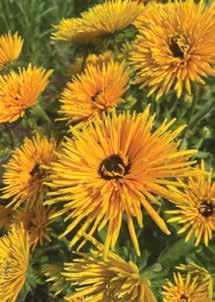
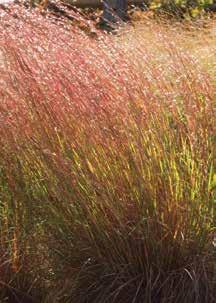
I knew when I saw this Coleus that I was going to build the kiosk pots around this beauty. Burgundy, pink with a little coral and yellow. It flowered some (as Coleus tend to do), but was easily maintained by deadheading and pinching.
Rudbeckia ‘Chim Chiminee’
This annual made an unexpected return from 2024 in our landing beds. Who doesn’t love it when plants come back?! I thought the quill shaped petals were gorgeous.
Anemone x hybrida ‘Whirlwind’
I have had struggles finding the right home for a Japanese Anemone. They need the soil to be moist but not soggy, some sun but some shade.
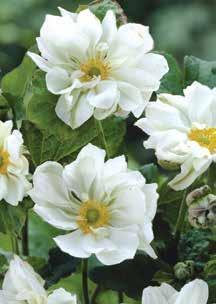
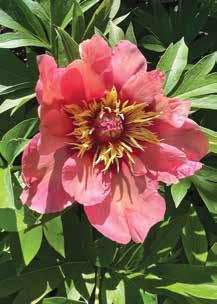
Finally, in the bed by the Longhouse Waterside Terrace, I have succeeded. They were gorgeous this fall dancing in the breeze.
Tulips
The small species varieties like ‘Tarda’ and ‘Tinka.’ These sweet little species tulips pack a punch. Planted together in small groups and in elevated spots they shine. Also because they are smaller they tend to hold up better in wet conditions.
Hairy Balls Milkweed (Gomphocarpus physocarpus)
They are so much fun and once those puffy green balloons adorn the stems they are our most asked about plant. Oh, and the monarch butterflies LOVE them.

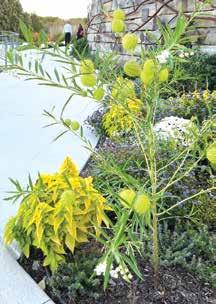


over five years. Their bright white plumes glow in the fall garden.
Perfect small grass that holds its shape and doesn’t flop. The fall color of this variety was spectacular and I loved the blue color during the summer.
Peony Itoh hybrid ‘Kopper Ketal’
A new variety for us. The raspberry/coral colored blooms were gorgeous this spring. I am looking forward to seeing it get bigger and better in the coming seasons.
Muhlenbergia ‘White Cloud’
So worth the wait, it is very late to flower…September for us this year. Technically zone 7, but we have ours in a very open area and it has come back, year after year, for
Viburnum ‘Opening Day’
Loving this snowball viburnum in the late spring. The fall color also was nice this year.
Gratitude
I am thankful for another wonderful year in the garden working with my amazing coworkers and fantastic volunteers, all devoted and hardworking. They truly are what make the gardens spectacular. I love chatting with visitors, saying hello to the regular walkers and showing kids fun things in the gardens. I hope that the end of your 2025 is bright and hope you are able to get to the gardens before the year ends.
Acouple of years back, while sitting on our backyard patio with Mrs. Gardener, I couldn’t help but admire the cones on a small spruce tree planted nearby. Unable to immediately recall its name, I rummaged through a pile of plant tags in my garage cabinet. Turns out, it is a Red Cone Norway Spruce, known botanically as Picea abies ‘Acrocona.’
The information tag described it as a small garden-sized tree, that grows up to 12 feet tall and 8 feet wide at maturity. Wow, that will definitely outgrow the bed where it is planted, I thought. More recently, though, I read on growers’ websites that this dwarf evergreen conifer can reach 5 feet by 4 feet in just 10 years. I’m okay with that, keeping my fingers crossed that mine stays small. It’s been in the ground for about eight years, so it looks like its on track to meet that milestone.
This is par for the course for me—to plant something that might outgrow its space. You see, I am the kind of gardener that requires instant gratification. When I’m done planting, I want everything to look finished. Not incomplete, or have that dreadful it’ll-look-better-in-acouple-of-years look. Thankfully, ‘Acrocona’ can stay where it’s planted—for now.
Through the last couple of gardening seasons I have snapped photos of its growth habit, like the lush


spring growth and the appearance of the unique cones. I remembered those pictures during another patio chat, when we simultaneously admired ‘Acrocona.’ As we thumbed through them, one photo in particular caught my attention. “This would make a great cover photo for the magazine, don’t you think?” Mrs. Gardener and I agreed. All of the photos used in this article are of our Norway Spruce, with one exception. The photo of the raspberry-red cones is sourced from a grower’s website.
Our tree has a whimsical and irregular broad pyramidal shape. That is normal. In fact, looking at it from all angles, it is not uniform at all. From the front, it looks good.
Then, I noticed the back. “Oh my! This looks like a Charlie Brown Christmas tree!,” I said. Like a tree with erratic growth, that view is a bit disappointing. The good news: from my Adirondack chair on the patio, the view is great.
What I love about this tree is how it’s nestled in between the patio column and the grilling area. It has effortlessly adjusted to the surroundings, leaving ample room to showcase the unstructured nature of its growth, while adapting to the curves of a few small boulders.
The cones of this conifer appear raspberry-red and start to form in early spring on last year’s branches. It also develops cones on the termi-
nal ends of the current season’s new growth. By summer, as the shoots grow longer, the cones mature to a pale or dark brown color and begin to droop downwards due to their weight. The cones remain throughout winter. Then, when the timing is right, the seeds hidden inside will be released and the cone will drop away.
I have not seen on my plant the raspberry-red color of the cones, as the name implies (and reflected in the photo on the opposite page). On my spruce, the cone color is light pink and the cone size is small. Perhaps this is due to the maturity of the plant, and/or that it is not planted in full sun.
This dwarf conifer is well suited as an accent plant, or in a rock or conifer garden, providing year-round interest. It prefers full sun but ‘Acrocona’ is said to appreciate some protection from the intense Midwest afternoon sun. These low maintenance trees prefer evenly moist, well-drained soils and will not tolerate standing water. Pruning is minimal for shaping or removing any dieback.
I hope you had a great gardening season and made a few connections with your plants, like I did. Take a moment to slow down and notice the different shapes and textures of each planting area in your landscape, public garden or neighborhood. Let nature’s beauty inspire you and your gardening endeavors!
Mike Cavanaugh is an avid plant lover and a true native Floridian. He owned a small tree nursery in central Florida for many years supplying trees to local landscapers. Inspired by the desire for a new adventure, he moved his wife, four kids and the family dog to the Midwest nearly 30 years ago. When family and friends asked why, he replied “I’m going to start a gardening magazine.” And the adventure continues.
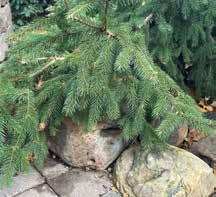


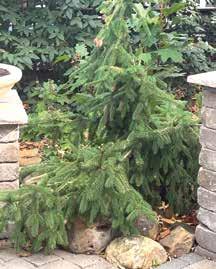





Happy H“OWL”-idays! While humans are preoccupied with decorations and gifts, local owls are skipping ahead to Valentine’s Day. Great Horned Owls (GHOWs) and Barred Owls (BAOWs) have adapted superbly to living (often unnoticed) alongside humans in urban and suburban areas. They differ in appearance and prefer slightly different habitats, but pursue similar lifestyles. In December, both seek mates and begin courtship rituals culminating in clutches of 2-3 eggs by late winter. It’s a wonderful season for observing these “night shift” hunters—their distinctive vocalizations are incessant, and they are more visible in bare trees.
Great Horned Owls are identified by their dark stocky bodies, head feather tufts, and imperious gold-

en eyes. They emit deep, ominous hoots, with the last drawn out (hoo, hoo-hoo, hoo, hooooh). Pairs create “duets” by hooting at each other. Like other birds of prey, females are larger than males, but males produce lower-pitched sounds. Barred Owls are “cute” by comparison: compact, with mottled, fluffy brown and white feathers, round heads and brown eyes. Their usual call is a nasal, squawking hoot, with a rhythm that sounds like “Who Cooks for You? Who Cooks for You AWWWL?”
Listen for these calls from dusk to dawn. Owls may call from atop your chimney or roof! Vocalizations reinforce relationships and remind neighbors that a pair has established their territory and will vigorously defend it. BAOWs rarely nest near GHOWs—the latter are twice as

large, more aggressive, and won’t hesitate to prey on their smaller cousins!
Owls set up housekeeping in tree cavities or appropriate old hawk, crow, or squirrel nests, occasionally utilizing nest boxes. (Always check dead trees for activity and leave them standing if possible.) Females begin incubation when their first egg is laid. Males supply food for 30-35 days until the eggs hatch in the order they arrived. Both parents hunt for their voracious young, and may be seen hunting in daylight as well as darkness. Unfortunately, the last chick to hatch is often disadvantaged. Its sibling(s) have 1-2 days’ head start in growth and ability to compete for food. Expired chicks nourish their nest mates—Nature wastes nothing.
Owls produce one brood annually and invest much time and resources in their offspring. Chicks begin climbing out of the nest and exploring branches at 4-6 weeks, but are unable to fly until about 10 weeks of age. Parents feed and protect them for several months after fledging, while they master the difficult art of hunting.
EVERYTHING is fair game for these adventurous eaters. Rodents are a staple food, but GHOWs enrich their diets with rabbits, quail, songbirds, reptiles, and even insects. They’re our only raptor capable of preying on adult skunks! In 1882, one scientist discovered 18 POUNDS of “leftovers” in one GHOW nest, ranging from fish to rats and rabbits. BAOWs like living near water, and love crayfish, which sometimes give their feathers pinkish stains.
Owls often bring prey to familiar feeding perches (near nests), and leave clues to their presence. Whitish feces (“whitewash”) may stain trees or posts, and oblong pellets containing undigestible hair and bones accumulate below.
Keep your eyes and ears open this winter and you may discover owl neighbors! Report sightings to eBird, or Cornell’s NestWatch program. (To prevent harassment of birds, please do not publicize specific nest or perch locations.)
For more information, see Mark Glenshaw’s fascinating articles and videos about the “Owls of Forest Park” (St. Louis) on YouTube and Blogspot. Mark has followed these GHOWs for 20 years and loves to tell their stories. Happy Birding!
Elizabeth Stoakes is a past President of Burroughs Audubon Society in Kansas City and has been birding for over 25 years. Please contact BAS via mail@burroughs.org or text/call 816-795-8177 with any birding questions.
When winter sets in and the garden beds are blanketed with frost or snow; it may seem like the growing season is over. The season is not at a complete standstill, winter is just a different kind of growing season. It’s a time for planning, preparing, and dreaming. In many ways, winter garden prep is a lot like meal prepping: both involve intentional planning, organizing, and laying the groundwork for the season ahead.
Just like your kitchen doesn’t shut down during a busy week, your garden doesn’t “close” during winter. Instead, it shifts focus. You might not be planting tomatoes or harvesting zucchini in January, but you can be:
• Cleaning and sharpening tools to be ready when planting begins.
• Ordering seeds and drawing out what will be planted in each bed.
• Starting seeds indoors for early crops like onion and coldhardy greens.
• Building raised beds, trellises, or cold frames for next season.
This kind of prep is essential because when the growing season arrives, things move fast—just like a hectic workweek where meals need


to be ready in minutes. Without winter preparation, your garden—and your meals—can fall behind.
Like You Feed Your Garden
Now, let’s take that garden mindset into the kitchen. Meal prepping is your way of “composting, mulching, and planning” for your body. It’s about thinking ahead, reducing waste, and making sure you’re feeding yourself nourishing meals—ideally using ingredients you’ve grown or preserved.
Let’s say you had a fall harvest of root vegetables like carrots, sweet potatoes, and beets. Maybe you’ve got garlic and onions in storage, and herbs like rosemary and thyme dried from summer. Here’s a sample two-day meal plan to help turn those stored and preserved ingredi-
ents into wholesome winter meals. Adjust it to fit your schedule, food preferences, and what you have on hand.
Roasted Root Vegetable Bowl:
Toss carrots, beets, and sweet potatoes, roasted with olive oil, garlic, rosemary, and sea salt. Roast until tender, then serve over a scoop of cooked quinoa and a tahini lemon dressing plus protein of choice.
Side: of pickled cucumbers
Hearty Garden Stew: A slowcooked mix of onions, garlic, kale, potatoes, and lentils. Season with thyme and bay leaves and add chickpeas. Serve with bread or homemade cornbread.
Lunch
Garden Frittata: Use leftover roasted veggies from Day 1, add beaten eggs, and bake. Sprinkle with dried chives or parsley.
Side: salad of shredded cabbage and carrots with an apple cider vinaigrette.
Stuffed Sweet Potatoes: Roast sweet potatoes, stuff with a black bean and corn mix (frozen corn from summer, if you preserved it). Top with a dollop of yogurt and fresh lime.
Snack: Apple slices with almond butter (perfect if you have stored apples from the fall harvest).
By planning meals this way—using stored produce, leftovers, and preserved garden ingredients—you stretch the value of your harvest and give yourself a nutritional head start during the winter.
Whether it’s your garden or your kitchen, the winter months are not downtime—they’re prep time. It’s when the quiet work happens: organizing seeds, sketching garden layouts, roasting vegetables, and portioning meals into containers. Both kinds of prepping serve the same purpose—sowing seeds for a more abundant, less stressful season ahead.
So the next time you’re chopping root vegetables for the week, remember—you’re gardening in your kitchen.
Sidney Patrick is a Field Specialist in Nutrition and Health Education with the University of Missouri Extension. She offers programming related to active aging, healthy eating, and physical activity in the Kansas City area. Email her at spatrick@missouri.edu for more information.
This month we focus on diminutive roses that offer unique beauty. We all love those huge blooms that grab our attention in the garden. How about considering smaller roses, usually on smaller plants, to offer variety and interest in next year’s garden? Winter months allow us time to browse the internet and catalogs to discover new treasures to try next season.
Polyanthas offer many small blooms in a wide range of colors that fill up the canes to make a big impact. They are shorter plants that grow wider than they grow tall. Many of the newer varieties are very disease resistant and require little care. A grouping along a border or hedge is quite pleasing and they also do well in containers.
The American Rose Society has recently created a shrub class for the ground cover roses that have become very popular. These roses have a growth habit much like polyanthas and generally are shorter than two feet. Drift® Roses and Flower Carpet® Roses are two brands that are easy to find, along with other options in garden centers and online. A wide range of colors give you endless design opportunities.
Miniature and miniflora roses are offered with both traditional hybrid tea-like form and many petaled blooms resembling small English type shrubs. While the lines are sometimes a bit blurry, miniature blooms are one and a half inches or less, while minifloras are larger. Likewise, the height and growth habit for miniatures is under two feet but certainly can be taller. It is possible to find climbing versions

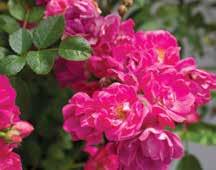
Polly®

Si is one of the tiniest microminiatures.
of both sizes as well. Check out the Sunblaze® series that are quite disease resistant and work well in containers and hanging pots.
RBG is a miniflora that is an example of the classic hybrid tea-like form that can be found in both miniatures and minifloras.
And if you are a collector of unusual roses, micro-miniatures may be of interest. Rare and hard to find, blooms on these little guys are usually about the size of a dime.
So, we have many options with these small bloom wonders to spice up your landscape. They work well in containers or groupings and can provide interesting color contrasts. Consider disease resistance as you
JERRY DREYER Consulting Rosarian

Miniature rose Sunblaze® Watermelon is both colorful and disease resistant.

Glamour
shop, as that will vary by variety. Be creative and you’ll be surprised at the compliments you’ll receive on these fun small bloom roses.
If winter rose preparation is not yet finished, there’s still time –consult the Winter Care tab under Grow Roses at www.kansascityrosesociety.org/ for more information. Guidelines are offered on the page on winter watering if there’s not enough precipitation.
Follow us on Facebook and Instagram and remember for all your rose questions, the Kansas City Rose Society experts are eager to help you at rosehelp@kcrosesociety.org.

Frost™ is a miniature climber that is very disease resistant and cold hardy.
With a name like this, this miniflora rose sets high expectations and easily exceeds them! Deep red, many petaled blooms cover this two-foot plant that put on show after show throughout the summer. It’s also hardy for our area and sets the standard for resistance to fungal diseases.

Jerry Dreyer is a Consulting Rosarian with the Kansas City and American Rose Societies. He has grown roses over 10 years each in Iowa, Minnesota and Kansas. Besides growing roses, he enjoys rose photography, competing in rose shows, grooming at the Loose Park garden, and hybridizing new roses.

Let’s be real for a moment. There are fewer plants that deer don’t eat than plants that they do eat. Secondly, there are too many deer in most of our neighborhoods, especially those in the outer rings of urban centers. Experts say that a healthy population of deer in urban areas should be less than ten animals per square mile. The Missouri Department of Conservation states that 20 is a socially safe and acceptable population.
Many municipalities that surround St. Louis have 60 to 100 deer per square mile. Some are working toward reducing that number through culling, which may seem cruel, but in reality, deer suffer greatly as their population grows beyond their environment’s carrying capacity. They go hungry and are killed or injured in car accidents. They are shunned by people, who are sick of the damage they cause to ornamental


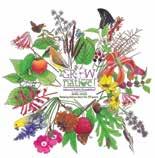
and crop plants, as well as newly planted trees. Homeowners spend millions of dollars on stinky, peppery-tasting products that deer supposedly don’t like. But in reality, when they are desperate and hungry, they eat the majority of plants and plant types.
As a professional horticulturist who designs and oversees the establishment of gardens, I can tell you that there are no product remedies that truly work. Most require weekly application—at great labor and material expense—especially during rainy seasons.
On the other hand, choosing to garden only with plants that deer don’t eat limits your plant palette to a paltry few. Why would we all garden with the same few plants, when everything we know about supporting wildlife states hinges on the fact that increased native plant diversity
is linked to an increase in wildlife diversity? Ideally, we should be planting dozens of species of plants, as many as realistically possible, including the ones that deer like to eat.
My final dose of reality, and what I have come to understand through 40 years of gardening, is that the best way to garden is with fewer deer. The only two ways to have fewer deer is by reducing their numbers through culling, and/or by excluding them with a barrier. Technically, deer barriers are considered fences and thus often fall under municipal regulation. However, many kinds of fences are intended to block views. Deer barriers are unobtrusive obstacles that are transparent and blend in.
Ordinances in many communities limit maximum fence height at 6 feet tall in front yards. Deer fences
need to be 8 to 9 feet tall to be effective (or two, 4- to 5-foot fences, 6 feet apart). They both work, though having a single fence is more costeffective and less visible. Most municipalities are allowing variances for temporary deer barriers. Having a fence up for two years helps plant populations become established, making them less vulnerable to decimating deer browse. That said, I’m not convinced that culling will ever bring deer populations down to acceptable numbers. There are limited and shrinking public funds available, even in wealthy communities to support deer-culling operations. The only truly viable option remaining is deer exclusion barriers. The sooner communities understand these realities, the sooner we will be able to have rich, beautiful, and diverse gardens that benefit humanity, and more importantly, the broader world of insect and animal diversity.
Scott Woodbury was the horticulturist at Shaw Nature Reserve for 30 years and stepped down from that position in June 2022. He continues to work on contract for Shaw Nature Reserve to carry out native landscaping education and launched his own business called Cacalia: Native Garden Design and Wilding. Find suppliers of native plants and seeds, as well as landscaping services, at grownative.org.

torch-lit-hike. Free program for all ages.
Raytown Garden Club
The club is taking a Winter Break in December and January 2026. Meetings will resume on the first Tuesday of the month from February thru November at Blue Ridge Presbyterian Church, Raytown, MO 64133. Guests are always welcome. Mark your calendar for February 3, 2026. For more information please check out our Facebook page: https://www. facebook.com/RaytownGardenClub
Luminary Walk
Select nights Nov 26-Dec 30; at Overland Park Arboretum & Botanical Gardens. Featuring adults-only nights, crowd-free electric glow nights, and new this year, accessibility-friendly glow cart tours. Visit OPABG.ORG for more information and to purchase tickets.
22nd Annual Winter Solstice Torch Lit Hike
Thurs, Dec 4, 5-7p; George Owens Nature Park, 1601 Speck Rd, Independence, MO 64057. The Annual Winter Solstice Torch-Lit Hike is a great option for those outdoor enthusiasts. We invite you to enjoy the changing of the seasons as you walk through the beauty of George Owens Nature Park. Feel the warmth from the campfire as you celebrate the winter solstice. Walk a paved trail lit by torches and enjoy live birds of prey, ice sculptures, and hot chocolate. Complimentary travel mugs in limited quantity. Master Gardeners of Greater Kansas City will be present to provide gardening information. For more information visit https://www.independencemo.gov/ events/21st-annual-winter-solstice-
Santa Paws in the Park
Dec 6, 1-4p; at Loose Park, 5200 Wornall, Kansas City, MO. Get into the holiday spirit with a holiday costume competition and parade, photos with Santa, mistletoe paw art, and more…! Register and learn more at https://kcparks.org/event/ santa-paws-in-the-park/.
Christmas in the Country Sat, Dec 13, 10a-4p; at Arnold’s Prairie Greenhouse and More!, 1430 Hwy 58, LeRoy, KS 66857. Come enjoy our peaceful country setting as you shop for holiday decorating and gift-giving. Holiday shopping event with artisans, food, make and take crafts and more. 620-964-2423
Plan It Native
Feb 10-11, 2026 at Kauffman Conference Center and Anita B Gorman Discovery Center. Registration now open. Full Access Ticket Price: $315. 21 Concurrent Sessions and a Vibrant Exhibit Hall. Native Landscape Design and Maintenance. Native Bee and Butterfly Conservation. Prairie Restoration Projects. Keynote Speakers: Camille Dungy, Author of Soil: A Black Mother’s Garden; Dr Abigail Lewis, Executive Director of Citizens for Conservation. Learn more and register at PlanItNative.org.
Kansas City Home & Flower Show
Feb 27-Mar 1, 2026; at Bartle Hall, Kansas City, MO Convention Center. The show boasts over 300 booths full of new and innovative products for upgrading your home and outdoor living space. Stroll through beautiful home, lawn, garden, and landscaping displays! Bring the
kids for FREE and experience fun entertainment for the whole family! Explore an Immersive and Rare Butterfly Exhibition! Enjoy live performances all 3 days by America’s Got Talent fan favorite “Puppy Pals” – a family fun action-packed show where adopted and rescued dogs perform spectacular stunts & breathtaking feats! Ticket prices: Adult $15, Youth 16 & under are FREE! One admission ticket is good for both the KC Home & Flower Show and the Missouri Big Buck Show next door! Show hours: Friday Noon-8pm, Saturday 10am-7pm, & Sunday 10am4pm; https://KCMOhomeshow.com/
Gardening Symposium in Paola, KS
“Nature, Science and Garden Design” Sat, Feb 28, 2026, 9a to 4p; Sponsored by the Marais des Cygnes Extension Master Gardeners, at Town Square, 15 Wea Street, Paola, KS. Speakers include Lenora Larson leading a soil safari, Dr. Jonathan Aguilar on being water-wise, Kristopher Dabner explaining garden design, and Anne Wildeboor about selecting the right plants. The $65 fee includes a box lunch. Pre-registration is required before Feb 13 at https://tinyurl.com/53hk3y7c. Find out more as it becomes available on: www.facebook.com/mdcemg or www.maraisdescygnes.ksu.edu or call the Paola Extension Office: 913294-4306.
with a Master
Join us for this Virtual class session on Dec 2 at 2p to learn more about how to take care of common plants that help us ring in the holiday sea-
son such as poinsettias, Christmas Cactus, Mistletoe and more. What is this plant? How do I grow this? What should I put in my garden? So many questions and no one to ask until now. Join the K-State Extension Office on a variety of gardening topics and be free to discuss your gardening questions with a Master Gardener. This session will also talk about common plants and trees grown in our landscape that provide a holiday feel.
K-State Garden Hour: Gifts for Gardeners
Join Calla Edwards for a fun virtual webinar on Dec 3 at 1p this holiday season! Finding the perfect holiday gift for gardeners can be a challenging task. These passionate individuals often spend their time outdoors and typically have an extensive collection of tools and supplies already. To assist you in your gift-giving endeavors, Calla Edwards, the Horticulture Agent for Butler County, conducted a survey among Master Gardeners and gardening enthusiasts. This survey revealed their favorite tools, supplies, and plants, providing you with a wealth of ideas for the gardener in your life.
garden events, club meetings, plant sales, and more for FREE! Send details to elizabeth@kcgmag.com
Deadline for the January issue is December 10.

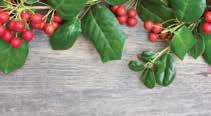


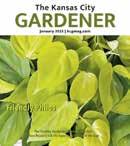
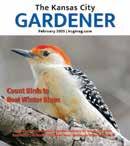











• Continue to mow as long as the grass is still actively growing.
• Spray or hand pull winter annual weeds
• If no seeding is taking place, apply pre-emergent herbicide to prevent winter annuals. Irrigation may be needed to activate the herbicide.
• Dormant seeding can start when temperatures drop below 40 °F.
• Remove large piles of leaves and debris, deeper than 3 inches, from lawn areas by bagging and removing, mulching them into the lawn, or moving them to an area off turfgrass.
• Do not leave large piles of leaves and debris (deeper than 3 inches) for an extended period, as it will kill the grass under it.
• Store unused fertilizers in a dry location and out of reach of children and pets.
• Store pesticides in a cool (not freezing) dry location, out of reach of children and pets.
• Review lawn service contracts.
• Water fall-planted grass as needed.
• Avoid extensive walking on frozen grass.
• Store unused seeds in a cool, dry location or refrigerator.
• Check vegetables and fruit in storage for spoilage.
• Mulch strawberries for winter protection.
• Clean and oil garden hand tools for winter.
• Till the soil and add organic matter.
• Store unused garden chemicals in a cool, dry, and safe location protected from freezing.
• Update garden journal for success and failure.
• Start planning for next spring on cold winter nights.
• Soil test to determine fertility needs.
• Keep heavy snowfall from limbs, lightly shaking to avoid damage.

• Avoid shoveling snow onto trees and shrubs.
• Protect the trunks of young trees with wraps or cages from rabbit and deer damage.
• Protect the trunks of thin-barked trees from western sun with tree wraps.
• Prune damaged and dead branches throughout the winter months.
• Water newly planted trees and shrubs in winter to prevent dry soil conditions.
• Mulch roots of tender shrubs such as azaleas and rhododendrons.
• Mulch on tree roots should be pulled away from the trunk to prevent root girdling.
• Mulch on tree roots shouldn’t be deeper than 4 inches to prevent rodents from nesting in it.
• Prune branches of junipers, pines, hollies, and other plants for holiday decorations.
• Rake and remove any leaves that are diseased to reduce reinfection in the spring.
• Mulch grafted roses by mounding soil 6 to 8 inches deep to protect the graft.
• Continue to plant spring flowering bulbs until the ground is frozen.
• Leave flower seed heads to feed winter birds.
• Leave hollow flower stalks for stem-nesting bees.
• Give plants or gift certificates as holiday gifts for gardening friends.
• Empty decorative pots and containers, store them inside.
• Start planning for next year by making notes and preparing orders.
• Turn compost pile to encourage winter breakdown.
• Make your Christmas list and add gardening supplies.
• Keep houseplants out of hot and cold drafts near vents and windows.
• Winter is a great time to soil test.
Johnson County K-State Research and Extension recommends environmentally-friendly gardening practices. This starts by identifying and monitoring problems. Cultural practices and controls are the best approach for a healthy garden. If needed, use physical, biological or chemical controls. Always consider the least toxic approach first. Markis Hill is the horticulture agent for Johnson County K-State Research and Extension. For free information fact sheets, visit www.johnson.ksu.edu, or call the Extension office at 913-715-7000.
The 2026 conference takes place Thursday, January 8 to Saturday, January 10 on the campus of Missouri Western University in St. Joseph, MO. Workshops will take place on Thursday; Conference tracks will take place on Friday and Saturday.
nference takes place Thursday, January 8 to nuary 10 on the campus of Missouri Western St Joseph, MO Workshops will take place on nference tracks will take place on Friday and er today at greatplainsgrowersconference org
Register today at greatplainsgrowerconference.org
2026 GPGC Keynote Speaker
Curtis Millsap
Farming as a Sacred Trust: Building Community at the Intersection of Land, Food, and People
For more information: Call (816) 279-1691 or email: buchananco@missouri.edu

January 8:

more information: Call (816) 279-1691 or Email: Buchananco@missouri
Extension Master Gardeners are ready to answer all your gardening questions.
CASS COUNTY
816-380-8194; Wed, 9am-noon; casscomg@gmail.com
DOUGLAS COUNTY
785-843-7058; dgcogardenhotline@gmail.com; Mon, Wed, Fri, 1-4pm
GREATER KANSAS CITY MISSOURI AREA
816-833-8733 (TREE); Mon-Fri, 9am-noon; mggkc.hotline@gmail.com
JOHNSON COUNTY, KS
913-715-7050; Mon-Fri, 9am-4pm; garden.help@jocogov.org
JOHNSON COUNTY, MO
660-747-3193; Wed, 9am-noon
LEAVENWORTH COUNTY

913-364-5700; Leave a message. A Master Gardener will contact you.
MIAMI COUNTY & LINN COUNTY
913-294-4306; Thurs, 8am-noon
WYANDOTTE COUNTY
913-299-9300; Mon-Fri, 9am-4pm
QUESTIONS ABOUT ROSES?
Ask a Rosarian; rosehelp@kcrosesociety.org; www.kansascityrosesociety.org



Use Sure Bloom® 6-7-6 or Natural on your indoor plants for beautiful blooms and foliage.

in to the Tobin Home & Garden Show Saturdays at 6 am with your questions. KMBZ.com Hosted by Mark Tobin! www.tobytobinsbackyard.com






For convenient mail delivery, complete the form below and send with your check for $38.00. You will receive a one-year subscription.



State, Zip:
Where did you pick up The Kansas City Gardener?
Please enclose your check payable to The Kansas City Gardener and mail with this form to: P.O. Box 8725, Prairie Village, KS 66208 The Kansas City Gardener is published

Bring home the scent of the season with lush, fragrant Juniper, Fir, Cedar and more.
• Fresh Christmas Trees
• Wreaths & Garland
• Greenery Bundles
With poinsettias from Suburban’s own Kansas farm and available in a dozen festive hues.


Our in-house designers craft original, holiday arrangements to bring festive color and texture to your indoor or outdoor displays. Custom orders available in stores.

Visit our 2025 Christmas Market at all Suburban locations, filled with fresh and festive decor for decorating and entertaining. Enjoy photos with Santa for kids, pets, and families as the season comes to life around you.
Find Santa’s Schedule at SuburbanLG.com/ChristmasMarket
